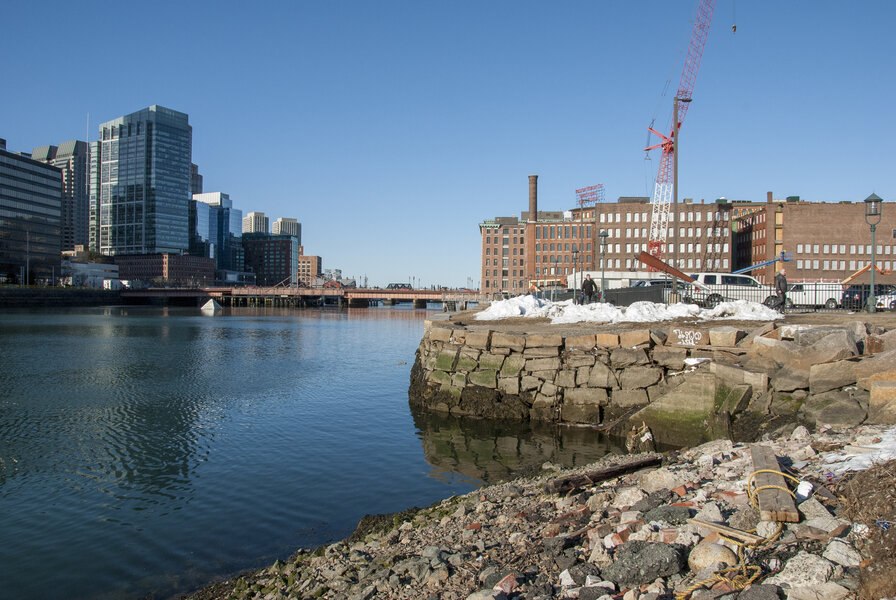As flooding frequency increases, more US cities opt for green infrastructure
Loading...
Boston’s Fort Point Channel is a dreary corner of an otherwise rapidly beautifying city. In the shadow of the glittering financial district, this thin canal lined with aging concrete factories could easily pass for the setting in a Charles Dickens novel. It’s also low-lying and right on the water – and that’s a problem. In 2018, record high tides brought on by nor’easters in January and March inundated the area several times with icy stormwater.
But last fall, Boston Mayor Martin Walsh announced plans for a network of public parks along the channel that could revitalize the waterway. The sloping banks of this grassy installation would serve as a catchment, protecting nearby neighborhoods from floodwater. The idea is an extension of a broader initiative, Climate Ready Boston.
American cities typically dredge rivers and build concrete walls along waterfronts to stem rising tides. But this so-called gray infrastructure can be unsightly, costly to maintain, and inflexible, says Kimberly Gray, professor of civil and environmental engineering at Northwestern University. Severe flooding is on the rise in the United States, according to the National Oceanic and Atmospheric Administration. As a result, urban planners from Boston to Houston to Milwaukee are increasingly considering transforming valuable waterfront real estate into climate-adaptable natural greenways.
“There are a number of powerful and necessary forces that are saying we need to make infrastructure improvements, particularly under these conditions of climate change and extreme events, and green infrastructure provides a very economically savvy way of dealing with it,” says Professor Gray.
The issue of rebuilding infrastructure generally draws a lackluster response from taxpayers, Gray says. But open wetlands and flood plains are aesthetically appealing and provide opportunity for recreation. At the planned Fort Point Channel Park in Boston, for instance, residents will be able to ride bikes and walk along the grassy waterfront when water levels are low. Wildlife, too, will benefit from the presence of natural ecosystems.
In Houston, even before hurricane Harvey’s record rainfalls, the city regularly saw its system of bayous overflow, says John Jacob, director of the Texas Coastal Watershed Program at Texas A&M University. Most neighborhoods here were built on low-lying prairies, and now nearly 40 percent of local flood plains house commercial or residential buildings, according to Dr. Jacob’s research.
But a new effort seeks to restore some of the city’s natural waterfront. The Bayou Greenways 2020 initiative has purchased more than 3,000 acres of land to develop linear parks. The goal, according to the Houston Parks Board, which oversees the project, is to bring usable green space back into the heart of Houston. Revitalizing the region’s natural hydrological system can also aid the absorption of floodwaters, notes Jacob. And building these parks challenges the notion that urban development and nature are incompatible.
“It’s a tremendous step toward getting to where we see these bayous as amenities rather than threats,” Jacob says.
But to fully achieve sustainable development across the country much more green infrastructure will be needed, and quickly, says Gray. “As we go forward, we’re finding increased urbanization, increased impervious areas, and more storms. Altogether, that is a formula for disaster,” Gray says.
Milwaukee is working to avert such disasters. In July 2017, the city announced plans to develop sewage and stormwater treatment projects using green infrastructure. The projects range from the expanding rain gardens to the redevelopment of natural wetlands along the Lake Michigan shoreline. Flooding has historically plagued the Great Lakes city, and runoff from heavy rainfall has carried toxic sewage into the region’s rivers and streams. Through green infrastructure development, the Milwaukee Metropolitan Sewerage District plans to capture and hold 740 million gallons of water every time it rains by 2035.
For other cities considering taking a lead from the likes of Milwaukee, it’s a matter of approach, according to Annalisa Onnis-Hayden, a professor of civil and environmental engineering at Northeastern University. “Welcome the water, but find a way to use those spaces as mitigation. It looks a lot better than building walls around the city.”






